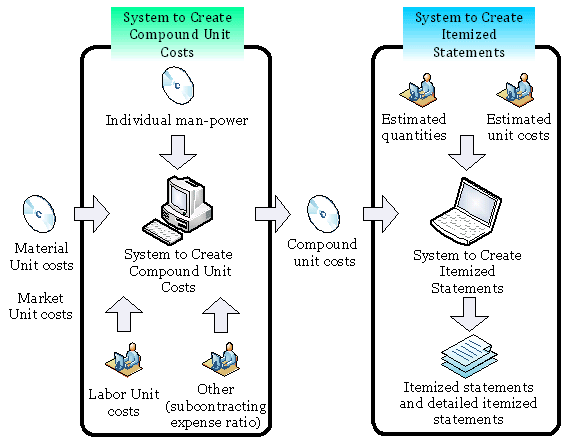2009. October
Research Institute on Building Cost (RIBC)
Outline of the RIBC development
In 1982, at the National Meeting of Head Construction Managers, which consisted of construction personnel from the Ministry of Land, Infrastructure, Transport and Tourism (MLIT), metropolitan and prefecture administrations and ordinance-designated cities, it was agreed that these participants would collaborate on the development and use of construction software. Thus, in order to develop estimation systems and to manage their use, the Council for the Use of Estimation Systems for Public Buildings was established.
RIBC is a calculation software for personal computers to estimate public building construction costs.
Initially, RIBC was developed based on an estimation standard of the Ministry of Construction, the Substantial Estimation Standard for Public Building Constructions.
In March of 2003, MLIT and other related ministries established the Estimation Standard on Public Building Constructions, and the new RIBC is based on this standard.
Outline of the RIBC system
There exist two formats for construction estimate forms for building works. One of the forms is organized by type of work (“MasterFormat” in USA), and the other by type of building elements and related sitework (“UniFormat” in USA).
RIBC uses the former format, classification by type of work.
In 2004, we added a new function to RIBC in order for it to work with outputs in the other format, i.e. classification by building elements.
The RIBC system consists of the System to Create Compound Unit Costs, which calculates compound unit costs by man-power, and the System to Create Itemized Statements, which creates detailed itemized statements.
The System to Create Compound Unit Costs creates tables on man-power and compound unit costs, using combined unit costs (material and labor unit costs) and subcontracting expense ratios as input data. It allows users to calculate compound unit costs (execution unit costs) simply by inputting material unit costs, which are provided with charge by Construction Research Institute and Economic Research Association, along with labor unit costs and other factors (such as subcontracting expense ratio).
Based on calculated compound unit costs, the System to Create Itemized Statements makes itemized statements by calculating direct costs of construction from estimated quantities, as well as common costs based on direct costs.
Overview of RIBC: Estimation System for Public Building Works

Functions of the System
- Calculating compound unit costs
- Making itemized statements
- Making itemized statements of changes
- Making itemized statements without prices
- Making itemized statements of work done
- Making unit cost lists and accompanying detailed statements
- Replacing all unit costs
- Comparison of changes over time
